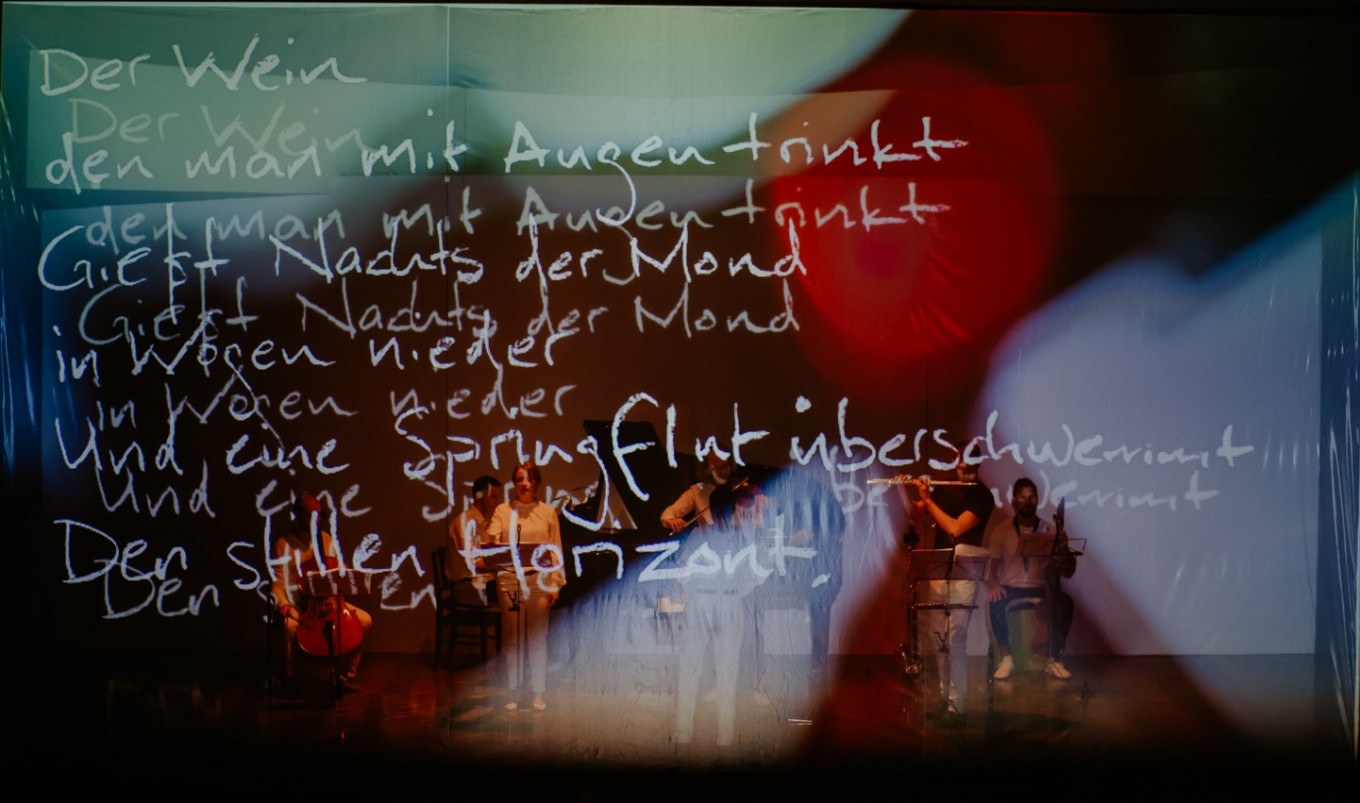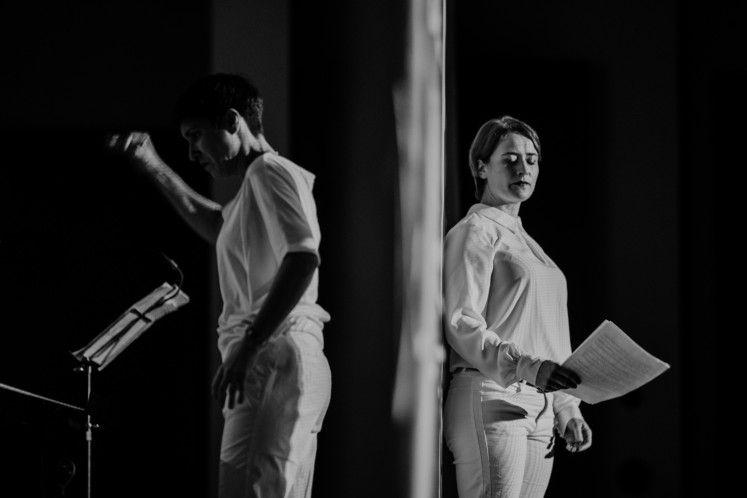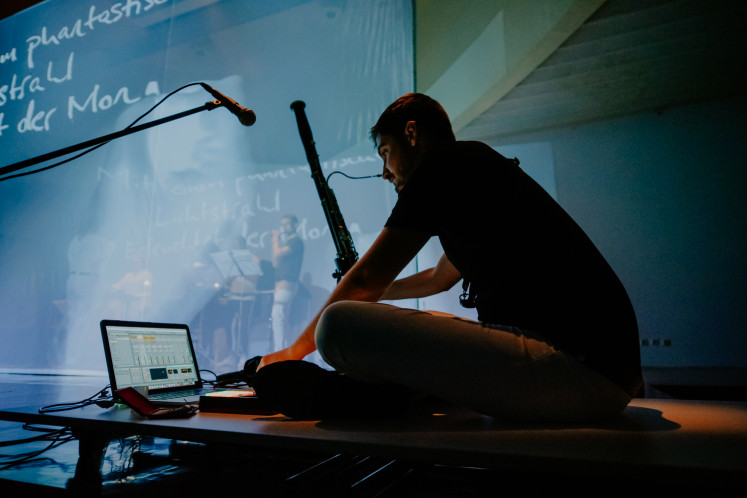Popular Reads
Top Results
Can't find what you're looking for?
View all search resultsPopular Reads
Top Results
Can't find what you're looking for?
View all search resultsExperimental music meets visual arts in ‘Pierrot Lumière’
Change text size
Gift Premium Articles
to Anyone
O
ne of the most important musical works of the 20th century has literally come to life in an experimental audio-visual performance by German music collective MAM.manufactur für aktuelle music.
MAM put their own edgy spin on Austrian-American composer Arnold Schonberg’s 20th century masterpiece Pierrot Lunaire, teaming up with graphic artist Andreas Huck from WARPED Type to create an engaging, multi-sensory experience.
The evening, held at the Goethe-Institut in Jakarta last Tuesday, marked the group’s first ever performance in Southeast Asia. MAM will also be performing the show around Southeast Asia, including Malaysia, the Philippines, Vietnam and Myanmar.
Pierrot Lunaire, which premiered in Berlin in 1912, is a melodrama centered on the eponymous character Pierrot. The performance, made up of a selection of 21 poems covering themes ranging from love and sex to religion, violence and blasphemy, was originally written by Belgian poet Albert Giraud in 1884.
MAM’s decision to perform Pierrot Lunaire – a groundbreaking work due to its atonality or lack of key, challenging established conventions of classical music at the time – was a conscious one.
“Normally we play [more] contemporary stuff,” said conductor Susanne Blumenthal. “But [Pierrot] links between traditional classical music and contemporary music, so we decided to bring it from Germany to [Southeast Asia] and create a new context for it.”
MAM’s take on Pierrot Lunaire – which they fittingly renamed Pierrot Lumière in a nod to the highly visual elements of their performance – is almost a hallucinatory experience.
A semi-transparent screen was stretched across the stage, just as it was over 100 years ago at the premiere of Pierrot Lunaire. However, unlike the original performance, Huck’s engaging visuals danced across the screen.
One by one, the musicians walked onto the stage, taking their places behind the screen, the projections reflecting onto them. At the front of the stage, two musicians sat on either side, surrounded by an array of instruments, objects and mixers.
Behind the scenes: Soprano Julia Spies (right) moves around the stage while conductor Susanne Blumenthal conducts from behind the screen. (Courtesy of Goethe-Institut Indonesien/-)
As the performance began, led by the crashing piano of Daniel Lorenzo and the soaring sprechgesang (spoken word) soprano of Julia Spies’ Pierrot, the visuals on the screen changed – replaced by the poem’s lyrics, written in German in real-time by an anonymous hand.
This was not your average performance of Pierrot Lunaire. Interspersed between the poems were interludes of improvised electronic noise – there were pre-recorded sounds of crickets and traffic, as well as sounds created live by an unusual selection of instruments and tools, from a bassoon to a fishbowl filled with water.
The musicians played into a microphone, using a combination of hardware and software to distort and digitally layer the sounds until it became a cacophony of noise, joining together the natural and artificial.
This idea of bridging the divide between two spaces was echoed in Huck’s visual projections. The original story of Pierrot Lunaire is vividly brought to life through the projections of both natural and urban spaces of forests and alleyways, through which Spies’ Pierrot wandered through as she sang, giving a theatrical element to the performance.
Clarinetist Richard Haynes said that creating these virtual spaces through both sound and image was a way to make the performance more relevant for Indonesian audiences.
“We did some field recordings [in Indonesia] and put them in the electronic sounds to create a new context here,” he said. “The natural visuals create a geographical link between where we come from and the places we are playing through the visuals and the sounds.”
Haynes said that performing these familiar sounds and images was a means of bringing 20th century ideas to a 21st century audience.
“The second part [of the performance] for example, refers to the idea of death, the afterlife and this idea of transcendence,” he said. “We decided to put it together with nature to make these ideas more general, to make this piece more relevant for us in Germany as well as people in Indonesia.”
Sounds of nature and urbanity: Alexander Hadjiev uses a range of tools to create an experimental soundscape. (Courtesy of Goethe-Institut Indonesien/-)
MAM was founded by the recipients of the International Ensemble Modern Academy scholarship in 2010, brought together by a common passion for creating exciting new forms of expression and performance in contemporary classical music.
By pushing musical boundaries, the young ensemble, the members of which range in age from 25 to 40, are aiming to generate interest among younger audiences.
It is a vision that MAM appears to be fulfilling, with a surprising number of younger faces among the audience members in Jakarta.
Caroline, a 16-year-old music student at the Goethe-Institute, said she enjoyed the performance, even though it was completely different from what she had expected.
“It’s surprisingly deep,” she said. “I thought it would be a normal soprano classical music performance, [but] when you looked at the meaning of some of the few words I knew, there was more meaning to it,” she said.
Although the young people of today are more likely to be seen at a pop concert than a classical music concert, Haynes said he would like to see a rejuvenation of the classical music scene.
“Going to the opera house or to a symphony orchestra concert has always been a ritual for a lot of people, it would be a place to be seen,” he said.
“My hope would be that we can continue to develop the community through the concerts we do, so that people – particularly young people – think it’s cool to listen to MAM, it’s cool to listen to this kind of music.”
In Pierrot Lumière, MAM challenges the notion that contemporary classical music is separated from people’s everyday lives.
“We are working against this idea and sometimes we are successful, but it’s a long way to show people that contemporary classical music is relevant,” Blumenthal said. “It’s important for people to listen to it. It’s not an arty form disconnected from life – it should be connected to society.” (ste)
-- The writer is an intern at The Jakarta Post













